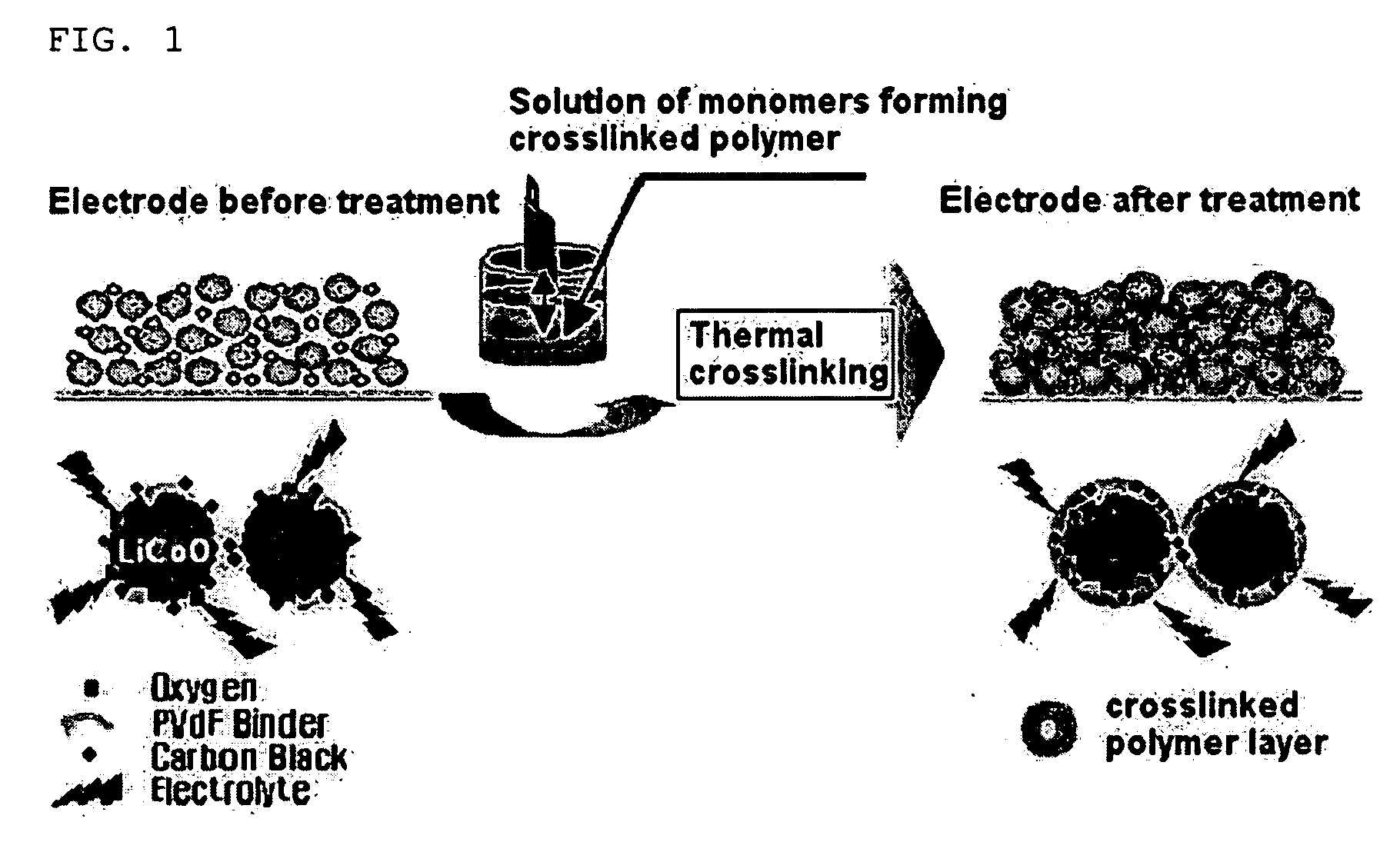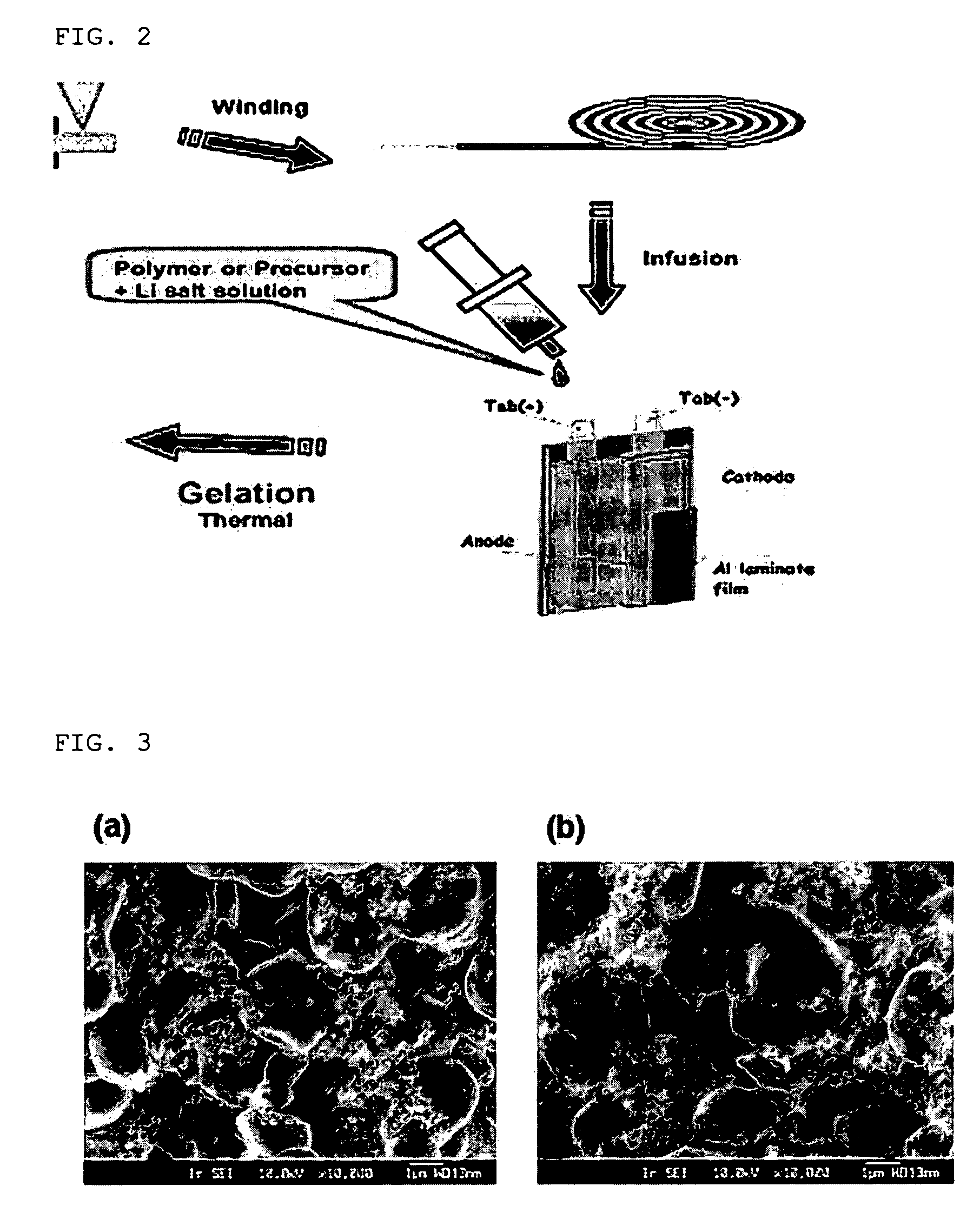Safety-improved electrode by introducing crosslinkable polymer and electrochemical device comprising the same
a crosslinkable polymer and electrochemical technology, applied in the field of electrochemical devices, can solve the safety problems of lithium secondary batteries, and relatively complicated manufacturing processes, and achieve the effect of improving battery safety and not adversely affecting battery quality
- Summary
- Abstract
- Description
- Claims
- Application Information
AI Technical Summary
Benefits of technology
Problems solved by technology
Method used
Image
Examples
example 1
Manufacture of Electrode Having Crosslinked Polymer and Lithium Secondary Battery Comprising the Same
[0064] (Manufacture of Cathode)
[0065] To N-methyl-2-pyrrolidone (NMP) as a solvent, 94 wt % of lithium cobalt composite oxide (LiCoO2) as a cathode active material, 3 wt % of carbon black as a conductive agent and 3 wt % of PVDF (polyvinylidene fluoride) as a binder were added to form slurry for a cathode. The slurry was coated on aluminum (Al) foil having a thickness of 20 μm as a cathode collector and dried to form a cathode.
[0066] TA10 crosslinking agent represented by the following formula 3 and AIBN (azobisisobutyronitrile) as a crosslinking initiator were dissolved into acetone at about 30° C. for about 1 hour to prepare a solution. At this time, the TA10 crosslinking agent and AIBN were used in an amount of 10 wt % and 0.2 wt %, respectively. Next, the cathode preliminarily manufactured as described was dipped into the solution for about 1˜3 minutes in a dip coating manner ...
experimental example 1
Analysis of Electrode Surface
[0073] The following test was performed to analyze the surface of the electrode according to the present invention.
[0074] The sample used in this test was the electrode obtained according to Example 1. The cathode of Comparative Example 1, obtained by a conventional method, was used as a control.
[0075] When analyzed the electrode surface by using Scanning Electron Microscope (SEM), the electrode coated with a crosslinked polymer according to the present invention showed a pore structure similar to the pore structure of the cathode according to Comparative Example 1, which were obtained by the conventional method and had no coating layer. Therefore, it can be seen that the electrode according to the present invention can maintain the pore structure formed among the electrode active material particles (see FIG. 3).
experimental example 2
Evaluation for Safety of Lithium Secondary Battery
[0076] The following test was performed to evaluate the safety of the lithium secondary battery comprising the electrode coated with a crosslinked polymer according to the present invention.
[0077] The sample used in this test was the electrode obtained according to Example 1. Each of the cathodes according to Comparative Examples 1 and 2, obtained by the conventional method, was used as a control. After each battery was charged to 4.2V, the battery was disassembled to separate the cathode and thermal safety was evaluated to a temperature of 400° C. by DSC (differential scanning calorimetry).
[0078] After the test, the lithium secondary battery of Example 1, comprising the electrode having a crosslinked polymer introduced onto the surface, showed a calorific value, which was significantly reduced as compared to the calorific values of the batteries according to Comparative Examples 1 and 2, comprising the electrodes obtained by the ...
PUM
| Property | Measurement | Unit |
|---|---|---|
| thickness | aaaaa | aaaaa |
| thickness | aaaaa | aaaaa |
| thickness | aaaaa | aaaaa |
Abstract
Description
Claims
Application Information
 Login to View More
Login to View More - R&D
- Intellectual Property
- Life Sciences
- Materials
- Tech Scout
- Unparalleled Data Quality
- Higher Quality Content
- 60% Fewer Hallucinations
Browse by: Latest US Patents, China's latest patents, Technical Efficacy Thesaurus, Application Domain, Technology Topic, Popular Technical Reports.
© 2025 PatSnap. All rights reserved.Legal|Privacy policy|Modern Slavery Act Transparency Statement|Sitemap|About US| Contact US: help@patsnap.com



